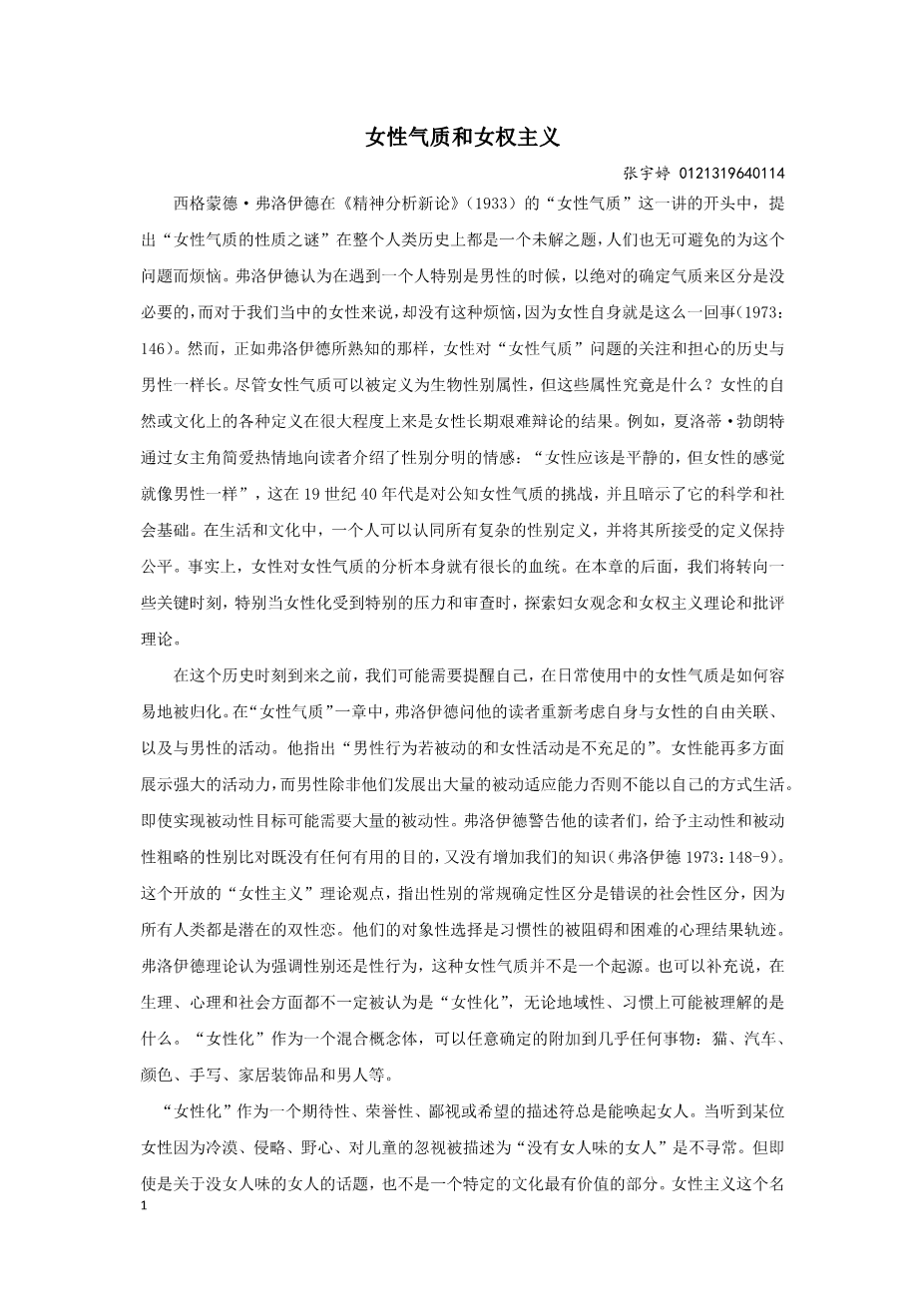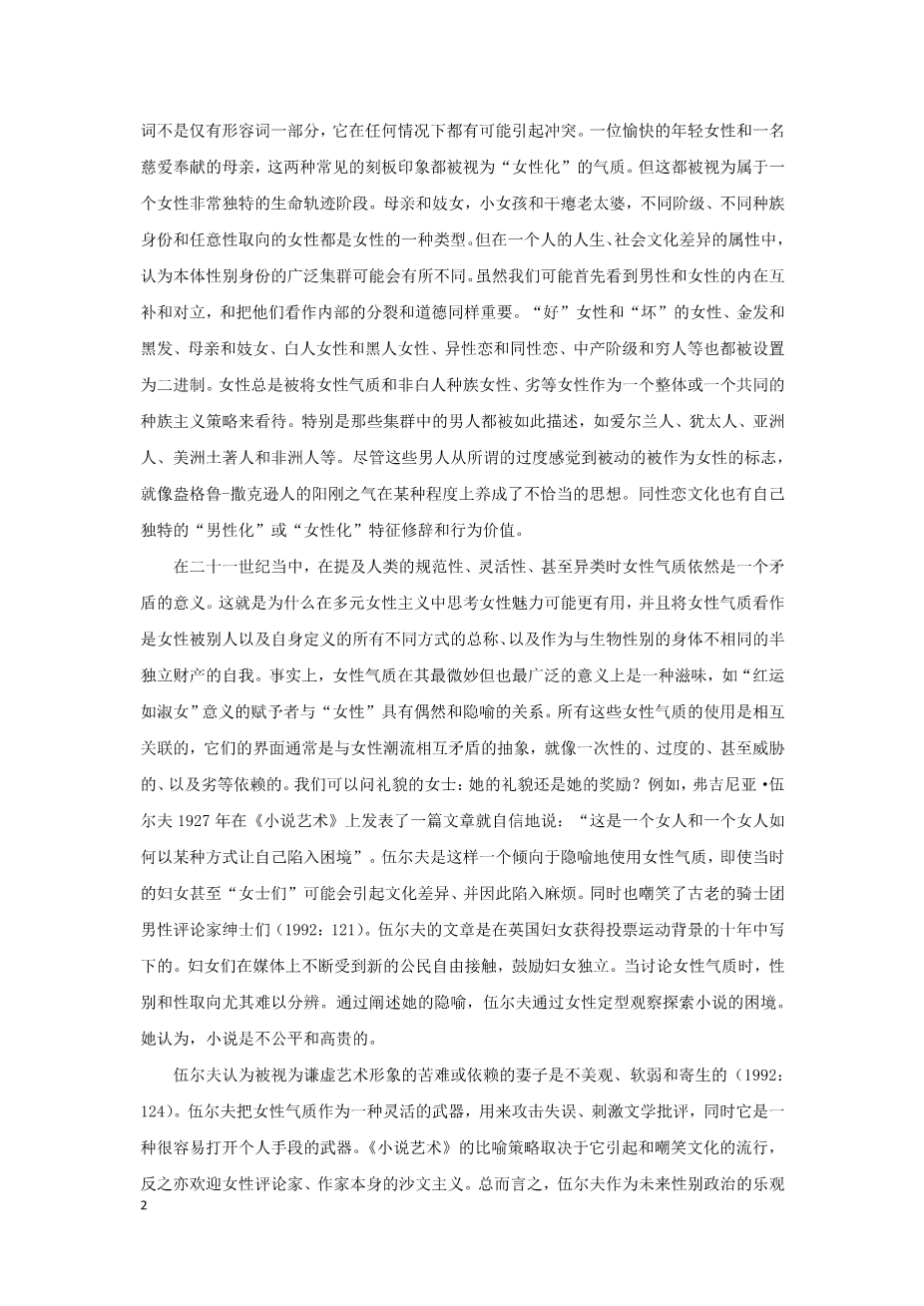

英语原文共 7 页,剩余内容已隐藏,支付完成后下载完整资料
1 FEMININITY AND FEMINISM
In the opening pages of lsquo;Femininityrsquo;, the fifth of his New Introductory Lectures (1933), Sigmund Freud poses the lsquo;riddle of the nature of femininityrsquo; as an unresolved question that lsquo;people have knocked their heads againstrsquo; throughout human history. Commiserating with one sex and winding up the other, Freud goes on, tongue-in-cheek, to separate and gender the subjects and objects of the interrogation: lsquo;menrsquo; it seems have not lsquo;escaped worrying over this problemrsquo; but lsquo;to those of you who are women this will not apply – you yourselves are the problemrsquo; (Freud 1973: 146). Yet as Freud knew very well, women had been lsquo;worryingrsquo; over the problem of lsquo;femininityrsquo; at least as long as men. For although femininity may be defined as a set of attributes ascribed to biologically sexed females, what exactly those attributes are, and the extent to which any given version of femininity is natural or cultural, have been debated long and hard by women themselves. When, for example, Charlotte Bronteuml;rsquo;s heroine, Jane Eyre, speaks passionately to the reader of the gendered division of emotions: lsquo;Women are supposed to be very calm generally: but women feel just as men feelrsquo;, she is challenging the commonsense understanding of femininity in the 1840s, and, by implication, its scientific as well as its social basis (Bronteuml; 1987: 96). In life as well as in fiction, one canboth lsquo;liversquo; a gendered identity in all its complexity, and hold its received definition at armrsquo;s length. In fact, the analysis of femininity by women has a long pedigree in its own right. Later in the chapter we will turn to some key moments when femininity was under particular pressure and scrutiny, exploring them through both womenrsquo;s fiction and feminist theory and criticism. Before we come to that history we may need to remind ourselves of how easily femininity in its everyday use naturalizes and genders so many other terms. In lsquo;Femininityrsquo; Freud asked his readers to reconsider their automatic association of passivity with women, and activity with men. He points out that it is lsquo;inadequate . . . to make masculine behaviour coincide with activity and feminine with passivity. . . . Women can display great activity in various directions, men are not able to live in company with their own kind unless they develop a large amount of passive adaptability.rsquo; lsquo;Even if,rsquo; he argues, one were to say that psychologically femininity gave preference to lsquo;passive aimsrsquo;, lsquo;a passive aim may call for a large amount of activity.rsquo; He warns his readers that to give activity and passivity crude gender alignments serves lsquo;no useful purpose and adds nothing to our knowledgersquo; (Freud 1973:148–9). The opening theoretical move in lsquo;Femininityrsquo; is to suggest not only that the conventional binaries that designate gender are convenient but mistaken social fictions, but that all humans are potentially bisexual – that their choice of sexual object is the result of an often impeded and difficult psychic trajectory. Whether the emphasis is on gender or on sexuality, Freudian theory makes femininity an outcome not an origin. We might add that to be a lsquo;womanrsquo;, biologically, psychologically and socially, is not necessarily to be thought lsquo;femininersquo; in whatever local and customary sense that may be understood. A promiscuous qualifier, lsquo;femininersquo; can and does attach itself to almost anything: cats, cars, colours, handwriting, home furnishings – and men. Yet
2 femininity and feminism
as an aspiration or an accolade, a despised or wished for descriptor, lsquo;femininersquo; always evokes lsquo;womanrsquo;. It is not uncommon, of course, to hear women described as lsquo;unfemininersquo;; supposed coldness, aggression, ambition, neglect of children or high intelligence can quickly bring this accusation upon them. But even so-called unfeminine women are inscribed, we might argue, with a femininity, if not always the one most valued by a particular culture. Femininity, the noun, is never quite the sum of its adjectival parts, which are in any case likely to be in conflict. The saucy flirtatiousness of a pleasure-loving young woman and the selflessness of the devoted mother – to take two common stereotypes – may both be considered lsquo;femininersquo; qualities, but they have historically been seen to belong to very distinct stages of a womanrsquo;s life trajectory. Mothers and prostitutes, little girls and old crones, women of different classes and ethnic identities and sexual orientations – all these supposedly discrete lsquo;typesrsquo; of the female – may be thought to lsquo;haversquo; femininity, but both within one lifetime and between social and cultural differences the cluster of attributes thought to make up their gendered identity may vary widely. And while we may first of all see masculinity and femininity as defined through their complementarity and opposition, it is equally important to see them as internally divided and moralized: versions of lsquo;goodrsquo; and lsquo;badrsquo; femininity – blondes and brunettes; mothers and prostitutes; white women and black women; straight and lesbian; middle-class and poor – have also been set up as binary terms. While femininity is always associated with femaleness it has been a common racialist strategy to ascribe feminine traits or femininity to non-white or other supposedly inferior ethnic groups as a whole. The men in those groups in particular – the Irish, Jews, Asians, Native Americans and Africans have all been so depicted – although what marks these men as feminine varies from supposed excesses of feeling to passivity to a degree of nurturance thought inappropriate in Anglo-Saxon masculinity. Homosexual cultures have their own rhetorics of lsquo;masculinersquo; or lsquo;femininersquo; traits and
femininity and feminism 3
behaviours, and value them differently than the homophobic and heterosexist societies that observe them. In the twenty-first century femininity persists as a contradictory constellation of meaning that can refer at once to normative, flawed and even lsquo;perversersquo; categories of the hum
全文共29384字,剩余内容已隐藏,支付完成后下载完整资料
资料编号:[145183],资料为PDF文档或Word文档,PDF文档可免费转换为Word


